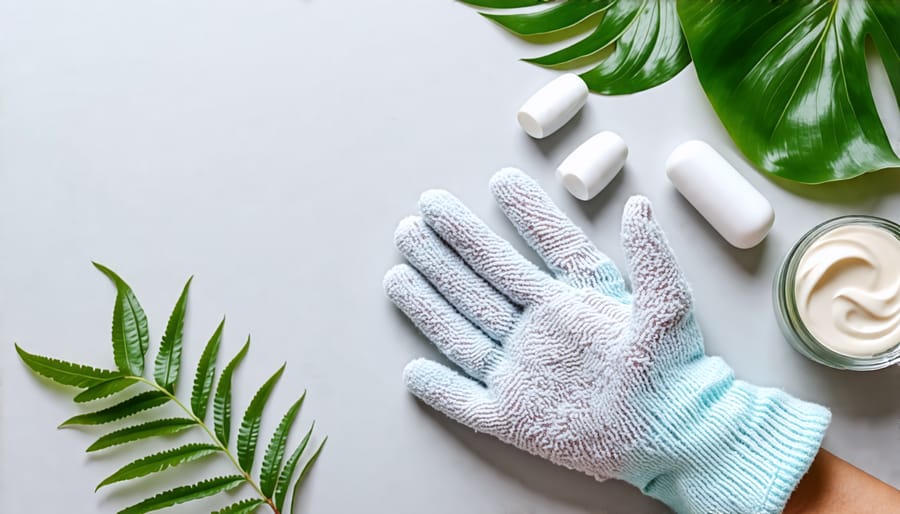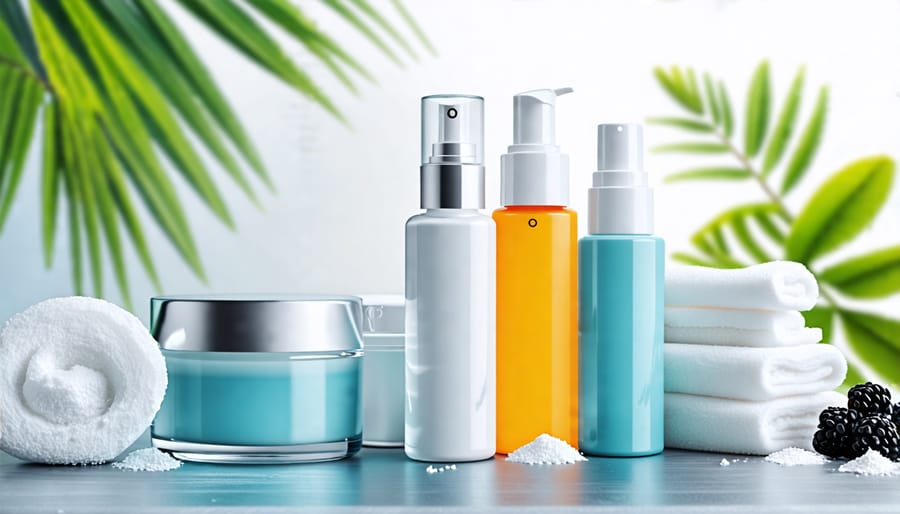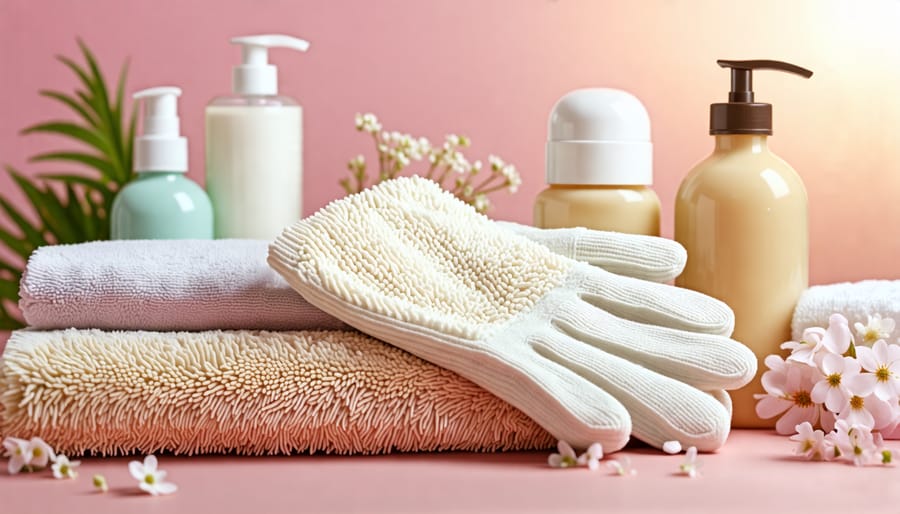Determine the right frequency by tuning in to your skin’s needs when using exfoliating gloves. First, assess your skin type; for sensitive skin, limit exfoliation to once or twice a week to prevent irritation, while those with oily skin might benefit from more frequent use. Check out what are exfoliating gloves for a deeper understanding. Next, monitor your skin’s reaction post-exfoliation; if redness or excessive dryness occurs, reduce usage. Incorporate gentle, circular motions without applying too much pressure to protect your skin’s natural barrier and promote circulation. Finally, ensure you follow up with a hydrating moisturizer to maintain the skin’s moisture balance and enhance its protective function. By following these expert-backed strategies, you can safely incorporate exfoliating gloves into your daily skincare routine, optimizing results while safeguarding your skin’s health.
Understanding Exfoliation
Exfoliation is a key component in maintaining healthy, vibrant skin. It involves the removal of dead skin cells from the surface, unveiling a smoother and more radiant layer beneath. There are two primary types of exfoliation: physical and chemical. Physical exfoliation uses tools or granular substances to manually slough off dead skin cells. Common methods include using scrubs, brushes, or exfoliating gloves. Chemical exfoliation, on the other hand, relies on active ingredients like alpha-hydroxy acids (AHAs) or beta-hydroxy acids (BHAs) to dissolve and remove the outermost skin layer.
Exfoliating gloves are a popular choice for physical exfoliation due to their convenience and effectiveness. Made from textured fabric, these gloves allow users to gently yet thoroughly exfoliate their skin by simply massaging in circular motions during a shower or bath. They help in enhancing circulation and promoting smoother texture, while also making skin more receptive to moisturizers and treatments applied afterward.
It’s essential to select the right type of exfoliation based on skin type and sensitivity levels. For those with sensitive skin, using exfoliating gloves might be more suitable a few times a week, rather than daily, to avoid irritation. Understanding your own skin’s reaction to exfoliation is crucial to achieving the benefits without causing harm. Exploring the right balance can lead to healthier, rejuvenated skin and can be part of a broader routine that supports overall wellbeing.

Benefits of Exfoliating Gloves
Improving Skin Texture
Exfoliating gloves are an effective tool for enhancing your skin’s smoothness and texture. By gently removing dead skin cells, these gloves help reveal a fresh layer of skin, leading to a more radiant and even complexion. Regular use can significantly improve the skin’s feel, making it softer and more supple. The gentle massaging action also stimulates blood circulation, promoting a healthier appearance. However, it’s important to balance exfoliation with your skin’s natural needs. Over-exfoliating can lead to irritation, so it’s best to listen to your skin and adjust frequency based on its response to maintain optimal texture and health.
Promoting Cell Turnover
Exfoliation plays a vital role in promoting cell turnover, which is a natural process where old, dead skin cells shed and new ones take their place. This process is essential for maintaining healthy, radiant skin. When you exfoliate, you help remove the outer layer of dead cells, making it easier for fresh, new skin to emerge. Regular, proper exfoliation can improve skin texture, enhance tone, and give your skin a natural glow. However, it’s crucial to strike a balance, as over-exfoliating, especially with abrasive tools like gloves, can harm the skin barrier. Approaching exfoliation thoughtfully supports skin renewal while keeping it healthy.
Risks of Daily Use
Skin Irritation
Using exfoliating gloves every day can potentially lead to skin irritation, a common concern for many Canadians interested in health and wellness. When used daily, these gloves can cause the skin’s surface to become overly sensitive, leading to redness and discomfort. This is because exfoliating gloves, while effective at removing dead skin cells, can strip away natural oils that protect and nourish your skin. The repeated friction may disrupt the skin barrier, resulting in increased sensitivity and a tendency towards irritation. For those with sensitive skin or conditions like eczema, daily exfoliation can exacerbate issues, making the skin more susceptible to damage. To prevent irritation, it’s advisable to limit the use of exfoliating gloves to two or three times a week, allowing your skin adequate time to recover. This balance ensures you enjoy the benefits of exfoliation without the discomfort of irritation, keeping your skin healthy and resilient.

Barrier Damage
Using exfoliating gloves too frequently can harm your skin’s protective barrier, which is vital for maintaining optimal health and moisture levels. This barrier acts as the first line of defense against environmental pollutants, allergens, and bacteria. When you exfoliate every day, particularly with abrasive tools like exfoliating gloves, you might strip away the natural oils and essential lipids that keep your skin healthy and resilient. As a result, your skin may become more susceptible to dryness, irritation, and even redness or flakiness. Over time, the weakened barrier could lead to heightened sensitivity and a greater risk of skin issues. To protect your skin, it’s important to balance exfoliation with adequate hydration and choose a frequency that suits your skin type. Those with sensitive skin might find exfoliating every two or three days more beneficial. Remember, listening to your skin’s needs can help you maintain its natural glow while preserving its essential protective functions.
Recommended Usage Frequency
Exfoliating gloves can be an excellent addition to your skincare routine, helping to slough off dead skin cells and promote a brighter, healthier complexion. However, the frequency with which you should use them largely depends on your skin type and individual needs. For individuals with normal skin, using exfoliating gloves about two to three times a week is generally sufficient. This frequency allows you to enjoy the benefits of exfoliation without risking over-sensitivity or irritation.
If you have sensitive skin, it’s best to limit the use of exfoliating gloves to once a week. Sensitive skin tends to be more prone to irritation, so a gentler approach will help prevent any adverse reactions. On the other hand, those with oily and more resilient skin types may find that exfoliating gloves can be used more frequently, perhaps three to four times a week, to help manage the excess oil and prevent clogged pores.
It’s crucial to listen to your skin and adjust the frequency based on how your skin reacts. If you notice any signs of irritation such as redness, dryness, or discomfort, reduce the frequency or switch to a gentler exfoliation method. Regardless of your skin type, always follow exfoliation with a nourishing moisturizer to maintain skin hydration and health.
Remember, while exfoliating gloves can enhance your skincare routine, they’re just one part of a comprehensive approach to skin health. Combined with a balanced diet, adequate hydration, and sun protection, regular exfoliation can help you achieve and maintain radiant skin.
Alternatives and Complementary Practices
Chemical Exfoliants
Chemical exfoliants offer a gentle yet effective alternative to using exfoliating gloves daily. They work by dissolving dead skin cells without the risk of over-scrubbing, making them ideal for those with sensitive skin or frequent exfoliation needs. Common ingredients like alpha hydroxy acids (AHAs) and beta hydroxy acids (BHAs) can help enhance skin texture and clarity. For a balanced skincare routine, these exfoliants can be used in conjunction with physical exfoliators. Embracing diverse beauty tools and treatments like chemical exfoliants and incorporating beauty rituals such as jade combs, can help you maintain glowing skin safely and effectively.

Moisturizing and Hydration
After using exfoliating gloves, it’s essential to focus on hydration and moisturizing to maintain healthy skin. Exfoliation can sometimes leave your skin feeling dry or sensitive, making moisturizing a crucial step. By applying a rich, nourishing moisturizer immediately after exfoliation, you help lock in moisture, soothe any potential irritation, and support the skin’s natural barrier. Look for ingredients like hyaluronic acid or glycerin, known for their hydrating properties. Incorporating this step into your routine ensures your skin stays soft, supple, and resilient, enhancing the overall benefits of exfoliation while preventing dryness or discomfort.
Conclusion
In conclusion, exfoliating gloves can be a valuable addition to your skincare routine, offering numerous benefits like improved circulation and smoother skin. However, it’s crucial to use them wisely to avoid potential risks such as irritation or over-exfoliation. Experts typically suggest using exfoliating gloves one to three times a week, depending on your skin type and sensitivity. For those with sensitive or dry skin, less frequent use may be best to prevent irritation. Remember to listen to your skin’s needs and adjust your exfoliation routine accordingly. When used correctly, exfoliating gloves can be an effective, safe, and affordable method to enhance your skincare regimen. Always ensure that your gloves are clean and replaced regularly to maintain hygiene and maximize benefits. For personalized advice, consulting a dermatologist can help tailor your exfoliation practices to your specific skin needs. Ultimately, incorporating exfoliating gloves into your wellness routine should be both practical and adaptable to your lifestyle.

